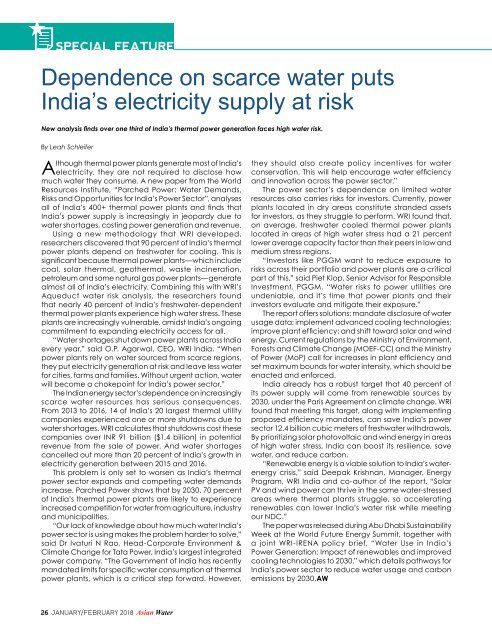AW JANFEB 2018 LOWRES
Create successful ePaper yourself
Turn your PDF publications into a flip-book with our unique Google optimized e-Paper software.
SPECIAL FEATURE<br />
Dependence on scarce water puts<br />
India’s electricity supply at risk<br />
New analysis finds over one third of India’s thermal power generation faces high water risk.<br />
By Leah Schleifer<br />
Although thermal power plants generate most of India’s<br />
electricity, they are not required to disclose how<br />
much water they consume. A new paper from the World<br />
Resources Institute, “Parched Power: Water Demands,<br />
Risks and Opportunities for India’s Power Sector”, analyses<br />
all of India’s 400+ thermal power plants and finds that<br />
India’s power supply is increasingly in jeopardy due to<br />
water shortages, costing power generation and revenue.<br />
Using a new methodology that WRI developed,<br />
researchers discovered that 90 percent of India’s thermal<br />
power plants depend on freshwater for cooling. This is<br />
significant because thermal power plants—which include<br />
coal, solar thermal, geothermal, waste incineration,<br />
petroleum and some natural gas power plants—generate<br />
almost all of India’s electricity. Combining this with WRI’s<br />
Aqueduct water risk analysis, the researchers found<br />
that nearly 40 percent of India’s freshwater-dependent<br />
thermal power plants experience high water stress. These<br />
plants are increasingly vulnerable, amidst India’s ongoing<br />
commitment to expanding electricity access for all.<br />
“Water shortages shut down power plants across India<br />
every year,” said O.P. Agarwal, CEO, WRI India. “When<br />
power plants rely on water sourced from scarce regions,<br />
they put electricity generation at risk and leave less water<br />
for cities, farms and families. Without urgent action, water<br />
will become a chokepoint for India’s power sector.”<br />
The Indian energy sector’s dependence on increasingly<br />
scarce water resources has serious consequences.<br />
From 2013 to 2016, 14 of India’s 20 largest thermal utility<br />
companies experienced one or more shutdowns due to<br />
water shortages. WRI calculates that shutdowns cost these<br />
companies over INR 91 billion ($1.4 billion) in potential<br />
revenue from the sale of power. And water shortages<br />
cancelled out more than 20 percent of India’s growth in<br />
electricity generation between 2015 and 2016.<br />
This problem is only set to worsen as India’s thermal<br />
power sector expands and competing water demands<br />
increase. Parched Power shows that by 2030, 70 percent<br />
of India’s thermal power plants are likely to experience<br />
increased competition for water from agriculture, industry<br />
and municipalities.<br />
“Our lack of knowledge about how much water India’s<br />
power sector is using makes the problem harder to solve,”<br />
said Dr Ivaturi N Rao, Head-Corporate Environment &<br />
Climate Change for Tata Power, India’s largest integrated<br />
power company. “The Government of India has recently<br />
mandated limits for specific water consumption at thermal<br />
power plants, which is a critical step forward. However,<br />
they should also create policy incentives for water<br />
conservation. This will help encourage water efficiency<br />
and innovation across the power sector.”<br />
The power sector’s dependence on limited water<br />
resources also carries risks for investors. Currently, power<br />
plants located in dry areas constitute stranded assets<br />
for investors, as they struggle to perform. WRI found that,<br />
on average, freshwater cooled thermal power plants<br />
located in areas of high water stress had a 21 percent<br />
lower average capacity factor than their peers in low and<br />
medium stress regions.<br />
“Investors like PGGM want to reduce exposure to<br />
risks across their portfolio and power plants are a critical<br />
part of this,” said Piet Klop, Senior Advisor for Responsible<br />
Investment, PGGM. “Water risks to power utilities are<br />
undeniable, and it’s time that power plants and their<br />
investors evaluate and mitigate their exposure.”<br />
The report offers solutions: mandate disclosure of water<br />
usage data; implement advanced cooling technologies;<br />
improve plant efficiency; and shift toward solar and wind<br />
energy. Current regulations by the Ministry of Environment,<br />
Forests and Climate Change (MOEF-CC) and the Ministry<br />
of Power (MoP) call for increases in plant efficiency and<br />
set maximum bounds for water intensity, which should be<br />
enacted and enforced.<br />
India already has a robust target that 40 percent of<br />
its power supply will come from renewable sources by<br />
2030, under the Paris Agreement on climate change. WRI<br />
found that meeting this target, along with implementing<br />
proposed efficiency mandates, can save India’s power<br />
sector 12.4 billion cubic meters of freshwater withdrawals.<br />
By prioritizing solar photovoltaic and wind energy in areas<br />
of high water stress, India can boost its resilience, save<br />
water, and reduce carbon.<br />
“Renewable energy is a viable solution to India’s waterenergy<br />
crisis,” said Deepak Krishnan, Manager, Energy<br />
Program, WRI India and co-author of the report. “Solar<br />
PV and wind power can thrive in the same water-stressed<br />
areas where thermal plants struggle, so accelerating<br />
renewables can lower India’s water risk while meeting<br />
our NDC.”<br />
The paper was released during Abu Dhabi Sustainability<br />
Week at the World Future Energy Summit, together with<br />
a joint WRI-IRENA policy brief, “Water Use in India’s<br />
Power Generation: Impact of renewables and improved<br />
cooling technologies to 2030,” which details pathways for<br />
India’s power sector to reduce water usage and carbon<br />
emissions by 2030.<strong>AW</strong><br />
26 JANUARY/FEBRUARY <strong>2018</strong> Asian Water



